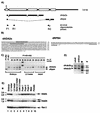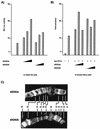Two different Drosophila ADA2 homologues are present in distinct GCN5 histone acetyltransferase-containing complexes
- PMID: 12482983
- PMCID: PMC140672
- DOI: 10.1128/MCB.23.1.306-321.2003
Two different Drosophila ADA2 homologues are present in distinct GCN5 histone acetyltransferase-containing complexes
Abstract
We have isolated a novel Drosophila (d) gene coding for two distinct proteins via alternative splicing: a homologue of the yeast adaptor protein ADA2, dADA2a, and a subunit of RNA polymerase II (Pol II), dRPB4. Moreover, we have identified another gene in the Drosophila genome encoding a second ADA2 homologue (dADA2b). The two dADA2 homologues, as well as many putative ADA2 homologues from different species, all contain, in addition to the ZZ and SANT domains, several evolutionarily conserved domains. The dada2a/rpb4 and dada2b genes are differentially expressed at various stages of Drosophila development. Both dADA2a and dADA2b interacted with the GCN5 histone acetyltransferase (HAT) in a yeast two-hybrid assay, and dADA2b, but not dADA2a, also interacted with Drosophila ADA3. Both dADA2s further potentiate transcriptional activation in insect and mammalian cells. Antibodies raised either against dADA2a or dADA2b both immunoprecipitated GCN5 as well as several Drosophila TATA binding protein-associated factors (TAFs). Moreover, following glycerol gradient sedimentation or chromatographic purification combined with gel filtration of Drosophila nuclear extracts, dADA2a and dGCN5 were detected in fractions with an apparent molecular mass of about 0.8 MDa whereas dADA2b was found in fractions corresponding to masses of at least 2 MDa, together with GCN5 and several Drosophila TAFs. Furthermore, in vivo the two dADA2 proteins showed different localizations on polytene X chromosomes. These results, taken together, suggest that the two Drosophila ADA2 homologues are present in distinct GCN5-containing HAT complexes.
Figures







Similar articles
-
Two Drosophila Ada2 homologues function in different multiprotein complexes.Mol Cell Biol. 2003 May;23(9):3305-19. doi: 10.1128/MCB.23.9.3305-3319.2003. Mol Cell Biol. 2003. PMID: 12697829 Free PMC article.
-
Host cell factor and an uncharacterized SANT domain protein are stable components of ATAC, a novel dAda2A/dGcn5-containing histone acetyltransferase complex in Drosophila.Mol Cell Biol. 2006 Feb;26(3):871-82. doi: 10.1128/MCB.26.3.871-882.2006. Mol Cell Biol. 2006. PMID: 16428443 Free PMC article.
-
Drosophila Ada2b is required for viability and normal histone H3 acetylation.Mol Cell Biol. 2004 Sep;24(18):8080-9. doi: 10.1128/MCB.24.18.8080-8089.2004. Mol Cell Biol. 2004. PMID: 15340070 Free PMC article.
-
The Gcn5 complexes in Drosophila as a model for metazoa.Biochim Biophys Acta Gene Regul Mech. 2021 Feb;1864(2):194610. doi: 10.1016/j.bbagrm.2020.194610. Epub 2020 Jul 28. Biochim Biophys Acta Gene Regul Mech. 2021. PMID: 32735945 Review.
-
The Ada2/Ada3/Gcn5/Sgf29 histone acetyltransferase module.Biochim Biophys Acta Gene Regul Mech. 2021 Feb;1864(2):194629. doi: 10.1016/j.bbagrm.2020.194629. Epub 2020 Sep 2. Biochim Biophys Acta Gene Regul Mech. 2021. PMID: 32890768 Free PMC article. Review.
Cited by
-
The SAGA subunit Ada2 functions in transcriptional silencing.Mol Cell Biol. 2009 Nov;29(22):6033-45. doi: 10.1128/MCB.00542-09. Epub 2009 Sep 8. Mol Cell Biol. 2009. PMID: 19737915 Free PMC article.
-
ATAC and SAGA co-activator complexes utilize co-translational assembly, but their cellular localization properties and functions are distinct.Cell Rep. 2023 Sep 26;42(9):113099. doi: 10.1016/j.celrep.2023.113099. Epub 2023 Sep 8. Cell Rep. 2023. PMID: 37682711 Free PMC article.
-
Drosophila USP22/nonstop polarizes the actin cytoskeleton during collective border cell migration.J Cell Biol. 2021 Jul 5;220(7):e202007005. doi: 10.1083/jcb.202007005. Epub 2021 May 14. J Cell Biol. 2021. PMID: 33988679 Free PMC article.
-
Functional characterization and gene expression profiling of Drosophila melanogaster short dADA2b isoform-containing dSAGA complexes.BMC Genomics. 2013 Jan 22;14:44. doi: 10.1186/1471-2164-14-44. BMC Genomics. 2013. PMID: 23336284 Free PMC article.
-
The homologous Drosophila transcriptional adaptors ADA2a and ADA2b are both required for normal development but have different functions.Mol Cell Biol. 2005 Sep;25(18):8215-27. doi: 10.1128/MCB.25.18.8215-8227.2005. Mol Cell Biol. 2005. PMID: 16135810 Free PMC article.
References
-
- Aasland, R., A. F. Stewart, and T. Gibson. 1996. The SANT domain: a putative DNA-binding domain in the SWI-SNF and ADA complexes, the transcriptional co-repressor N-CoR and TFIIIB. Trends Biochem. Sci. 21:87-88. - PubMed
-
- Balaguer, P., A. M. Boussioux, E. Demirpence, and J. C. Nicolas. 2001. Reporter cell lines are useful tools for monitoring biological activity of nuclear receptor ligands. Luminescence 16:153-158. - PubMed
-
- Barlev, N. A., R. Candau, L. Wang, P. Darpino, N. Silverman, and S. L. Berger. 1995. Characterization of physical interactions of the putative transcriptional adaptor, ADA2, with acidic activation domains and TATA-binding protein. J. Biol. Chem. 270:19337-19344. - PubMed
-
- Belenkaya, T., A. Soldatov, E. Nabirochkina, I. Birjukova, S. Georgieva, and P. Georgiey. 1998. P-element insertion at the polyhomeotic gene leads to formation of a novel chimeric protein that negatively regulates yellow gene expression in P-element-induced alleles of Drosophila melanogaster. Genetics 150:687-697. - PMC - PubMed
Publication types
MeSH terms
Substances
Associated data
- Actions
- Actions
LinkOut - more resources
Full Text Sources
Molecular Biology Databases
